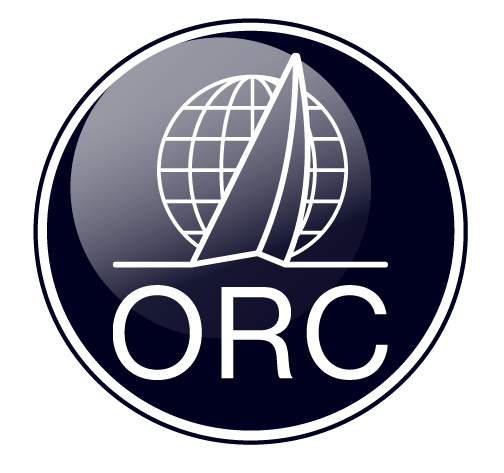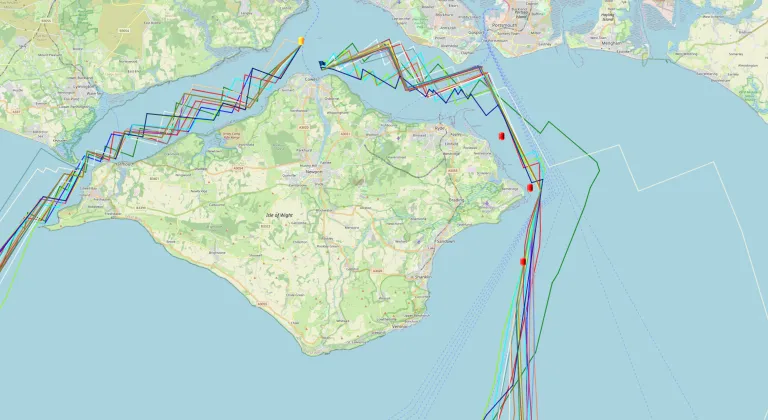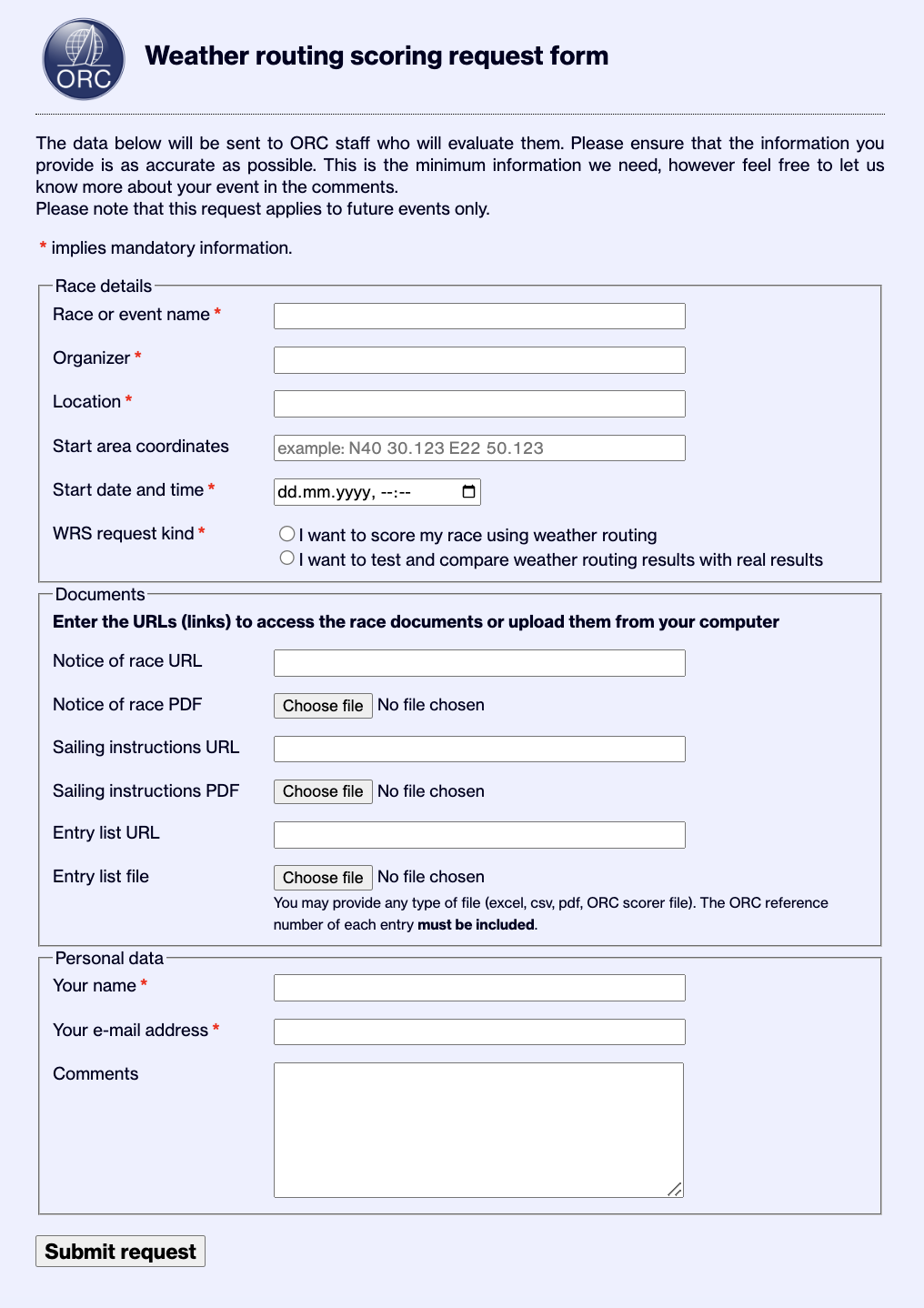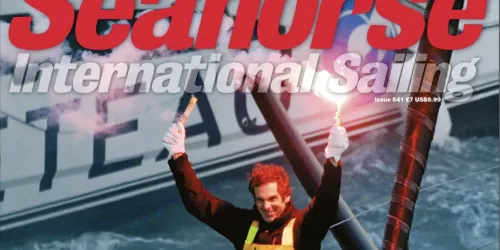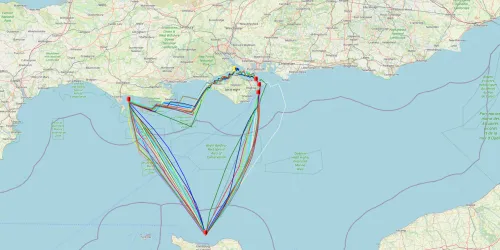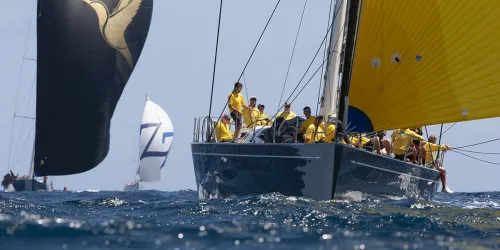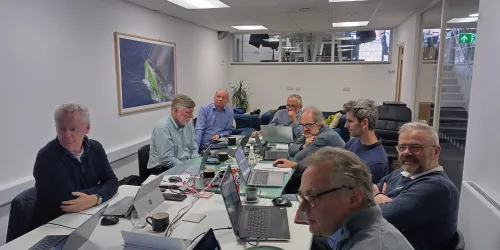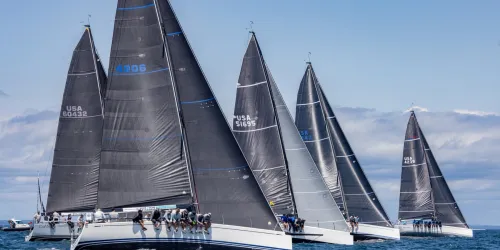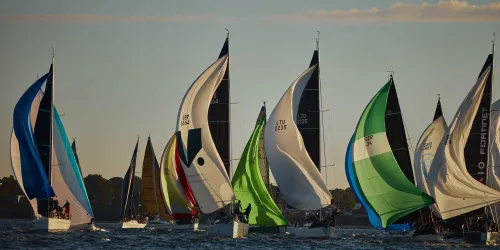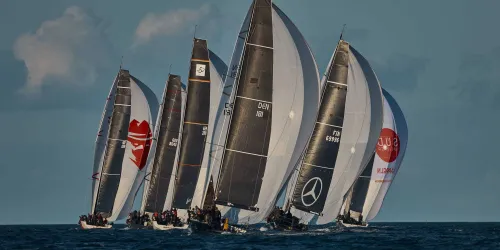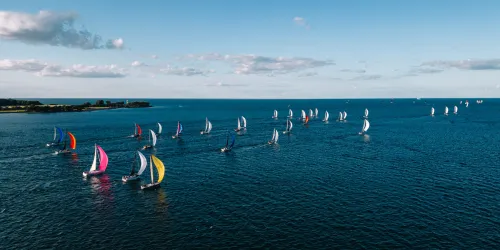Q & A - ORC Weather Routing Scoring (WRS)
ORC - Weather Routing Scoring (WRS) Q&A
Q: When should Weather Routing Scoring be considered for use?
WRS is best used for coastal or long-distance races where the typical race duration is 5 to 72 hours, or the start and the finish locations are different (such as an “island hopping” regatta). Note also that the RaceFlow app can be used to give predictions of race duration to assist with course setting.
Q: Is Weather Routing Scoring being better than existing scoring methods?
Yes, for suitable races WRS provides a more equitable scoring option than the All-Purpose Handicap. The TWS TWA mix derived from WRS is always more appropriate for scoring than that assumed by the APH. The Predicted Elapsed Time (PET) for the race using WRS is always closer to the real Elapsed Time than that calculated from APH (PETAPH = APH x Course length).
The APH wind distribution, and any pre-calculated distribution that has some upwind sailing, i.e. 0 deg. TWA, will generally be less reliable than WRS.
Using APH, when the TWA is less than the boat’s optimum upwind TWA then VMG is used for handicapping the assumption is that all upwind sailing is directly into the wind. But the upwind sector of the predicted distribution has 3 angle “bins” (sectors) between a TWA of 0 and 45 degrees, all of which have entries. This indicates that whilst the mark needs to be reached by tacking, there is a long and a short tack, and the routing accurately catches how much time is spent close hauled.

Q: Is the system too complicated for reliable use?
No. Testing over the 2024 season proved very satisfactory for competitors and race managers alike. The RaceFlow app will incorporate automated checking of the race set up and TCF’s. If you can use a Satnav, then you can use RaceFlow.
Q: How long before the start should ratings be determined?
About 2-4 hours before the race, depending on the schedule of available new weather forecasts. The organizer should specify in the NoR and SI when the TCF ratings will be published.
Q: How are TCF ratings determined from the PET’s?
The ORC (or the OA) may choose a scratch boat in the fleet and assign its TCF = 1.0000. Then another boat’s TCF’s will be calculated relative to the PET of that boat. The process is described in detail in a separate document.

Q: Which forecast and current model will be used for routing the fleet?
There is no requirement to choose a weather forecast or current model. PredictWind will select the best forecasts based on availability in the locale and duration of the forecast. When possible, the routing will use a blend of short-term high-resolution forecasts with longer duration lower resolution models.
If a race organizer wishes to select a particular forecast this can be done as part of the race set up.
Q: Does WRS account for tidal and/or oceanic currents?
Yes, the PredictWind routing engine uses the best available for the locale. The availability of current models is described on the PredictWind website.
Q: Will WRS work when boats may stop on the racecourse due to lack of wind, either predicted or encountered?
Areas of no wind are a feature of many offshore races; they happen on the race course and they appear in the forecasts. It’s been a problem for race scoring since handicap racing began. Experience suggests that even when there is no wind, sailors can keep the boat moving somehow. If weather forecasts were to be believed, boats might never escape the Doldrums, but they do.
The WRS will make sure that boats keep moving slowly through zones of very light winds. This will ensure that the predicted elapsed times are not distorted by a few boats whose simulated tracks make very large deviations to avoid calm patches.
Q: What happens if a race is shortened?
The TCF’s posted pre-race should be used.
WRS is designed to generate the handicaps for the specific race. If the race is shortened, the handicaps shall remain the same. Published ratings must not be changed after the start of the race (except as permitted by ORC rules in case of a measurement protest and/or correction of an error in the certificate).
A predicted elapsed time (PET) for each boat is determined by the routing process based on the predicted weather of the race. If the race course is shortened the TCF’s are not adjusted, this assumes that the boats experienced the same mix of conditions for the shortened race as for the original course.
Q: Can an OA use the grib files after the race or after the start for recalculating the scratch sheet?
This is not recommended because most competitors want to know their ratings and time allowances to optimize their strategy and tactics during the race.
Q: What if, when the routing deadline is reached, the race organizer does not know the exact location of the start line or needs to use an additional mark for the first leg of the course. Could this affect the distance and scoring of the race?
There may be very few occasions where adjustments to the start line position or windward mark positions would require the pre-race scratch sheets to be adjusted. The predicted TCF’s will change by a very small amount for minor discrepancies between the submitted and actual course, especially for races of long duration.
Q: In which format will WRS ToT ratings be available to the organizers? Will it be in a format that can be imported to Manage2Sail, Yacht Scoring or other scoring software programs, or will it need to be done manually?
The ToT ratings (scratch sheet) are available in XML format, and JSON and CSV formats, so this can be automated for programs that use these formats. Others may have to be entered manually.
Q: Will this option be available in the ORC Scorer software?
For 2025 the WRS TCF’s will be calculated by the ORC staff using ORC Scorer or the RaceFlow app.
Q: Will WRS be available for offshore races that my Club organizes? What if the OA wants to test WRS without committing to its official use? How do we contact ORC for this service and what specific information is needed?
Yes, during 2025 this will require cooperation with the ORC staff for both official and shadow-scoring purposes. This is described on the application available at this link: https://data.orc.org/public/wr.
Q: How does the routing software avoid land and exclusion zones?
For land avoidance the routing relies on the PredictWind router methods. Each boat is routed using a water depth limit based on its maximum draft. The example illustrations show how well the software deals with the problem of beating out of the western Solent.
Exclusion zones must be set by the Race Organizer in the scoring software. This is done in the course-setting display by setting the exclusion polygons using the vertex locations (i.e, lat, long). Once set the zones are saved for future use.
Q: Does WRS risk letting a poorly sailed boat win?
No more so than any existing scoring system. The differences in corrected times in an actual race get larger than the predicted times among the less well-sailed boats. An example is shown below among 50 entries in the 220-mile 2024 Bayview-Mackinac Race in the USA:

The handicap changes between APH or a historic course model and WRS are meaningful, but not able to compensate for sailing badly.
Q: Does WRS compensate when a race finishes in a dying or building breeze?
Yes, it does this very well. An example is shown below from the 2024 ORC European Championship in Finland:

Q: Is the “horses for courses” a real effect?
Depends on what you mean by ‘real’. For boats of the same class WRS will have no effect on the results in that class, and within a small APH band of similar boats WRS will have little effect. But where boats of different styles and performance strengths are competing against each other, for example a Class 40 vs. a Farr 40, WRS will offer a more equitable handicap to the Farr 40 when the wind is strong and abaft the beam and likewise help the Class 40 if the wind is light.
As a thought experiment, a race around the English Channel was simulated to quantify the differences between the APH and WRS. The course was 175 miles long, the race started at midday and the finish times were entered based on the TCF’s from the All purpose handicaps based on a scratch boat of 475 sec/m which corresponds to a boat like a Farr 40. With these finish times, if every boat sailed to match her APH the result would be a dead heat, all the boats would finish with a corrected time of 23:07:41.
When the race was simulated using WRS the predicted elapsed times (WRS PET), based on the anticipated wind and tide conditions, could be checked against the APH results.
The table below shows the result.
- The WRS predicted elapsed times are all shorter than those for the APH prediction.
- The WRS corrected times are calculated using the APH TCF, again all the WRS corrected times are shorter than the APH values.
- Using the WRS CT we no longer have a dead heat, there is a difference of several hours between the first and last boat. The DazCat 1295 is 07:59:17 faster than its APH prediction, Whilst the Farr 395 is only 00:32:08 faster than her APH prediction. The WRS positions show the DazCat in 1st place and the Farr in 22nd place, more than 6 hours behind on corrected time.

Thus in a simulated race use of the single number can advantage one boat over another by 25% of the race duration.
If this race had actually been sailed, and the weather forecast been perfect and the crews sailed at 100% then the WRS scratch sheet would have produced a dead heat.
Taking this experiment further a second race was simulated, same fleet, same start time, only the course was sailed in reverse.
The start time was the same and the APH derived finish times must be same because the course length is the same, and so the corrected time is again 23:07:41 for the whole fleet.
The WRS simulation delivers the following for the reversed course.

The corrected time order is markedly different.
The differences between the clockwise and anti-clockwise races are shown in the graphic below. The x-axis is the two races; the y-axis is the difference in corrected time between each boat and the winner. This is the time benefit that each competitor gives the winner when APH is used rather than WRS. It also shows how this gift is distributed through the fleet.
Take the TP52, for example; in race 1 (41231 Ch), she has given the winner a 2-hour gift, whilst the group of 40’ boats that finish 3-4 hours behind the winner have given the TP52 an hour. In the race that sailed the course in reverse, the TP52 still gifts the winner a bit more than two hours, but the forty footers are now giving her more than four ‘free’ hours.
In a single race, across this very mixed fleet, the ‘horses for courses’ effect is of the order of hours, and amongst the regular cruiser racers it is several tens of minutes. Not only that, if the course were sailed in the opposite direction the free gifts are distributed entirely differently. It would be very disheartening to start a race knowing that if the weather matches the forecast you will have to give a boat 10 feet longer than you four more hours of corrected time than it deserves.
Similar analyses running the same race day after day show similar behaviour, the single number, one size fits all, All Purpose Handicap is indeed never as good as WRS at offering equitable time allowances, whatever the weather.

The Procedure and Terms in the WRS
Weather Routing Scoring (WRS) promises to be the most accurate and objective scoring method available today. It merges modern weather routing from PredictWind and rated polar performance from ORC to achieve results that help filter out the luck factor from offshore racing.
The details are described in the following Q & A and should help guide race organizers and sailors to how and when it should be used in coastal and offshore races.
The following description outlines the procedure and explains the terms used in the Weather Routing Scoring system.
The ORC certificate shows the Polar Speed Curves in winds from 6-24 knots on all points of sail. The speeds are shown as knots and seconds/mile.
The WRS system calculates a Predicted ElapsedTime (PET) for each boat to sail the course.
For example, the fastest boat (Boat-F) has a PET of 10 hours, and the slowest boat (Boat-S) has a PET of 15 hours. A boat between them (Boat-M) is predicted to take 12 hours to complete the course.
How does the Organising Authority (OA) handicap Boat-M against Boat-F and Boat-S?
The WRS calculates a PET for each boat to sail the course.
Using the PETs, we calculate a Time on Time (ToT) correction factor (TCF) for each boat. The Corrected Time (CT) is calculated by multiplying the actual Elapsed Time (ET) with TCF.
The OA chooses a Scratch Boat in the fleet, say Boat-M. We fix her TCF at 1.000.
Corrected Time = PET x TCF; therefore, Boat-M’s corrected time is 12 x 1.000 = 12 hours.
Boat-M’s corrected time is exactly equal to her Predicted Elapsed Time.
Then, we calculate the TCF for Boat-F and Boat-S.
For all 3 boats to be ranked equal (a dead heat), their Corrected Times should be the same, therefore:
Boat-F
PET = 10 hours. The CT to be equal with Boat-M must be 12 hours. Therefore TCF = 12/10 = 1.200
Boat-S
PET = 15 hours. The CT to be equal with Boat-M must be 12 hours. Therefore TCF = 12/15 = 0.800
Our simulated Timing sheet looks like this
Boat |
PET hours |
TCF |
CT (PETxTCF) hours |
Boat-F |
10 |
1.200 |
12.00 |
Boat-M |
12 |
1.000 |
12.00 |
Boat-S |
15 |
0.800 |
12.00 |
When the race is sailed, the boats are not automatons, the crew will make mistakes, and the wind may not exactly match the forecast. The actual timing sheet could therefore look something like this.
Boat |
Start Time |
Finish Time |
ET hours |
TCF |
CT (ETxTCF) hours |
Position |
Boat-F |
08:00 |
18:30 |
10.50 |
1.200 |
12.60 |
2 |
Boat-M |
08:00 |
20:15 |
12.25 |
1.000 |
12.25 |
1 |
Boat-S |
08:00 |
00:30 |
16.50 |
0.800 |
13.20 |
3 |
